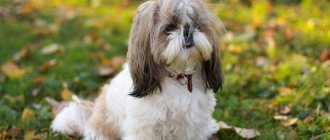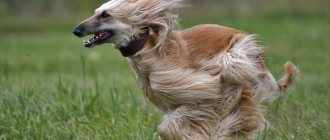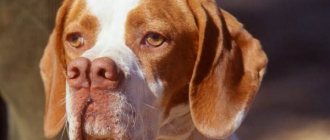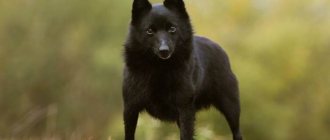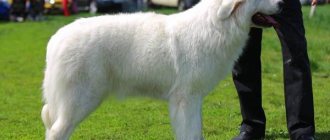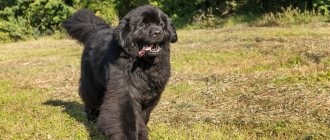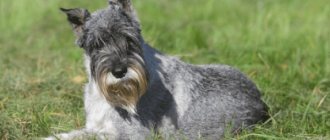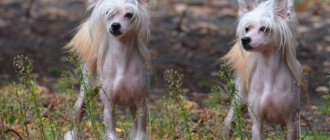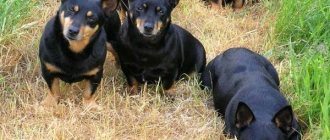Whether it's a neat haircut or a genetic blessing, there are dogs that naturally resemble the most famous big cats on the planet. Yes, you understood correctly, we are talking about dogs that look like lions.
Although the last common ancestor of dogs and cats lived 42 million years ago, some modern dog breeds boast the thick manes, fierce temperaments or golden fur of their distant cousins, the lion. Also found in nature are wolf dogs and dogs that look like foxes.
However, not all lion dogs are huge; some you can even carry in your purse! So you can choose the right leonine-looking pet for you to protect your home, play with the kids, or just snuggle up with you on the couch. Want to look at more unusual dogs? Then check out these pocket dog breeds or dog breeds with dreadlocks.
Description and features
Little Levchens have been known for many centuries, but as an independent breed they were included in the registers of the FCI only in 1961. The latest version of the FCI standard was created in 1995. It provides some information about the breed and what an ideal lion-like dog should be like.
- Origin. Europe, presumably France.
- Purpose. Companion dog.
- Classification. A group of companions, a subgroup of bichons and lapdogs.
- General description. Smart dog, truly homely, affectionate. Has the best qualities of a companion dog. The animal must be cut a la “lion”. The presence of a mane is mandatory. The back of the body, including the tail, is clipped. A tassel is left at the end of the tail.
- Head. Short, the upper shelf of the skull is wide.
- Nose. With a noticeable, black lobe. The bridge of the nose is slightly elongated.
- Eyes. Large, round with dark retina. The deep set and shape of the eyes makes the look smart and attentive.
- Ears. Long, hanging, covered with long fur, hanging almost to the shoulders.
- Neck. Holds the head high enough, which emphasizes the inner nobility of the animal.
- Body. Proportional to height, slender.
- Tail. Moderate length with the obligatory lion tassel at the end. Lövchen always holds it quite high and proud in the photo.
- Legs. Slender, straight. When viewed from the side and front, they are parallel to each other and stand vertically.
- Paws. With gathered fingers, rounded.
- Wool cover. The undercoat is dense and short. The guard hair is long. Straight or wavy is possible, but not curly.
- Color. Can be anything. Plain or with spots (except eyebrows).
- Dimensions. Height from 25 to 32 cm, weight less than 8 kg. Usually 5-6 kg.
Traditionally, the hair on the head, neck, and shoulders of the Levchens is not cut; strands that are too long are trimmed a little. Starting from the last rib, the body is cut completely. A long “lion” tassel is left on the tail. The limbs, like the body, are cut to zero. Except for the ankles. Fur cuffs are formed on them.
Despite all the signs of a domestic, “sofa” dog, the desire for movement is inherent in the character of the Levchen . He enjoys spending time outdoors. Needs regular, active walks. When meeting strangers, be they dogs or people, the Levchen does not show aggression, but is not afraid either.
Poi
Despite their charisma and past popularity, many breeds are now ghosts of history. For example, the poi breed was popular in Hawaii. Poi is believed to have evolved from the Polynesian kuri. The Polynesians brought these dogs to Hawaii. Gradually a new breed was formed. The poi were fed primarily on baked corms. The dish was called poi. Hence the name of the breed. The diet affected the appearance of the dogs. They were up to 40 cm tall at the withers. On high-calorie plant foods, they quickly recovered. The dogs looked more like little fat pigs. They moved lazily on their short legs and loved to rest in the dust. This is exactly how Cook described them when he visited Hawaii.
By entering a lucid dream, you can control your future: we learn to do this
The head of Rospotrebnadzor told where it is better to spend the May holidays
A banal “don’t worry” is unlikely to calm a person: what can replace it?
Genetic evidence suggests that the poi were closely related to the dingo. Dogs have been kept as pets by the islanders for centuries, despite their almost complete lack of functional role, be it hunting or guarding, transport or herding.
History of the breed
Levchen - a small lion dog , according to connoisseurs of this breed, appeared before 1434. This year a portrait of the Arnolfini couple was painted. In addition to the main characters, the Dutchman van Eyck depicted a Bichon Lyon or a lion dog in the painting.
Not everyone agrees with this. Some dog experts believe that the Brussels Griffon is present in the picture. Be that as it may, Europe experienced a Renaissance, accompanied by a lion's dog. Levchen was present in the paintings of Goya, Durer, and other artists.
In 1555, the Swiss scientist Konrad Gesner (he is called the second Leonardo da Vinci) in his four-volume work “History of Animals” included the Löwchen in the classifier of dogs under the name “lion dog”. This was the first printed mention of the little lion dog.
European countries debated where the little lion originated. Germany, the Netherlands, Italy, and France aspired to become the dog’s homeland. In northern Europe, the Löwchen was believed to be a relative of the poodle. In Mediterranean countries they believed that dogs had Bichon blood in their veins.
Noble ladies were of little interest in the origin of the dog. They enjoyed commanding the tame, tiny lion. In addition, the ladies experimentally found that dogs have warm skin. Especially in the back of the body. Levchens began to be used as heating pads. To enhance the effect, the second half of the body was completely shaved off.
For Russia, the Levchen is a very rare breed of dog.
The Lövchens even received the nickname “Europe’s hot water bottle.” After all, all the castles, palaces and other high society mansions were poorly heated. Dogs not only kept princesses, countesses and princesses warm, they often found their way into rural homes.
Living on peasant farmsteads, levkhens warned the owners about the appearance of strangers. We have mastered catching rodents. In palaces and farms, lion dogs won the favor of their owners primarily with their optimism, cheerfulness and devotion.
In the 18th century, the Levchen breed began to leave the scene. In place of little lions, pugs, bichons, and Pekingese made their way into aristocratic salons. They climbed onto the laps of the nobles. Terriers and herding dogs worked tirelessly on the farms. There is no place left for little lions in this world.
The breed almost completely disappeared by 1950. Enthusiasts have taken up the task of restoring the Bichon Lyon or little lion. All the purebred Levchens were collected, no more than a dozen of them remained. The recovery process went quickly. In 1961, the FCI recognized the breed. Now the existence of little lions is not in danger.
Newfoundland
If lions were brown or black, they would look like Newfoundlands. These large pets are known to be the cutest dogs and are often called "nanny dogs" because they are great with children.
Fun fact: Like their big cat cousins, Newfoundlands love water—in fact, they are natural swimmers , which is why they are born with partially webbed feet.
Newfoundlands take part in many water rescue operations, working as ship dogs for Canadian fishermen. If you have children and live near a lake, definitely consider making a Newfoundland part of your family! Here are some more dog breeds for kids.
Character
Levchen - the lion dog is naturally endowed with a positive attitude. The combination of toy royalty and sociability brought the animal to aristocratic salons. Here the dog got a taste for nobility. Several centuries among graceful ladies and gallant gentlemen - as a result, the dog acquired impeccable manners.
At the same time, the animal has not lost the sincerity and devotion that the aristocracy lacks. Constantly demonstrates an open, friendly attitude and love for people and other animals. The little lion gets along well with children. It’s not easy to tolerate children’s pranks, especially for a dog that looks like a toy.
Can be wary with strangers. With sudden movements, screams, in situations that, from the point of view of the little lion, pose a threat, they begin to bark. But they don’t raise their voice in vain, and they don’t treat “sneaky” dogs. When attacked, he can rush to defense, even if the enemy is stronger and larger. That is, the Levchen is dog .
To observe the surrounding environment, choose a higher place: the back of a sofa or chair. But most often it tries to end up on a person’s lap or hands. The little lion appreciates a family environment. Does not get in the way, but wants to be aware of everything.
Levchen loves when people pay attention to him. If necessary, he reminds that he is the best creature in the world. If a quarrel arises in his presence, he will try to resolve the conflict and take measures to smooth out the misunderstanding that has arisen.
The worst test for a levchen is to be left alone. Dogs do not tolerate separation well, even for short periods of time. If left alone for a long time, they can become depressed. There are cases where stress due to the owner's departure caused partial baldness of the animal.
Caring for the Lewchen's coat requires careful grooming.
Deerhound
- The maximum height and weight of males is 80 cm and 50 kg.
- The maximum height and weight of females is 70 cm and 35-43 kg.
These greyhounds were bred to hunt deer. The predecessors of the Deerhound were the dogs of the Scots and Picts, who helped people hunt ungulates. For a long time the breed was unknown outside of Scotland and only in 1892 was it officially recognized. Deerhounds are very hardy, have instant reactions and a very keen sense of smell. They rarely bark, and are very trusting of people, so they are unlikely to be good guards. But this is a great dog for a hunter.
Nutrition
As puppies, small dogs, including Lewchens, grow quickly. Therefore, their diet should contain a sufficient amount of animal proteins. Despite the indoor, “toy” size of the dog, the main thing in the dog menu is lean meat, poultry, and offal
Levchen puppies should receive a portion, half of which consists of meat components. A raw egg, added once a week, is a source of protein no less significant than meat. Bones and dogs are inseparable things. But tubular bones cannot be given to dogs. In addition, all spices, sweets, chocolate and the like are abolished.
Adult dogs can receive about 40% of their total food from animal food. A lot depends on how much the dog moves. Vegetables and fruits are a source of vitamins and fiber no less important than meat. If a dog happily chews a raw carrot or apple, it also cleans its teeth.
Many dogs eat porridge with pleasure. They are healthy, but you cannot replace other foods with oatmeal. Boiled cereals and porridges are second-line foods. Should make up approximately 20% of the total dog's dinner weight. Cheerful dogs have a good appetite. You cannot indulge animals or keep them from hand to mouth.
Tosa Inu
- The maximum height and weight of males is 82 cm and 100 kg.
- The maximum height and weight of females is 65 cm and 90 kg.
The Tosa Inu was originally bred in the Japanese kingdom of Tosa as a fighting dog. Representatives of the breed vary significantly in size. The Japanese breed generally weighs between 36 and 61 kg, while breeders outside of Japan have focused on producing dogs that weigh between 60 and 100 kg. The Tosa Inu was crossed with large European dog breeds such as the Mastiff, St. Bernard, and Bull Terriers to produce a larger, stronger animal.
Reproduction and lifespan
Small lion dogs live quite a long time, up to 14-15 years. To live this long, you first need to be born. Unfortunately, purebred dogs, including small lions or Bichon Lyons, have no control over this.
At about six months of age, the owner decides whether to be a parent to the dog or not. Dogs that have preserved reproductive function can have offspring at 1-1.5 years. It is better for females to skip the first estrus; males give the best offspring when they are a little over a year old.
Purebred animals breed under the supervision of a breeder or owner. Conception, gestation and birth of puppies are similar to a proven technological process. This is understandable - the health of producers and offspring, purity of the breed and commercial interest are at stake.
Which dog is the most expensive?
Top 10 most expensive dogs
- Dogo Argentino – $8,000. ...
- Canadian Eskimo Dog - $8,750. ...
- Rottweiler - $9,000. ...
- Azawakh - $9,500. ...
- Tibetan Mastiff - $10,000. ...
- Chow chow - $11,000. ...
- Levchen - $12,000. ...
- Samoyed - $14,000. The Samoyed dog from Siberia ranks first in the ranking of the most expensive dogs in the world.
9.06.2021
Care and maintenance
Large dogs always know their place, often they are not even allowed into the house. Companion dogs do not get away with anything, they are in constant contact with a person, and can even climb into bed. Therefore, the health and cleanliness of sofa creatures is the health of the whole family.
The Lewchen's paws require careful inspection and cleaning after each walk. Otherwise, the animal will share with all households a full range of pathogenic bacteria, helminths and everything that may be present on the soil or asphalt.
Levchens need regular walks in the fresh air and physical activity
The activity of the dog leads to the accumulation of dirt and dust among the long hairs. Hair may form into lumps or tangles. Daily brushing is an important procedure that gives the animal a neat appearance and maintains its health.
The dog's eyes are partially protected by strands of wool. This does not always prevent contamination. Every day the large, expressive eyes of the levchens are examined and washed. Do the same with the ears. The sinks are completely closed and therefore require careful monitoring. Ear disease is a common problem in lop-eared dogs.
A full haircut is done once every 6-8 weeks. For dogs participating in competitions, proper grooming is one of the main criteria for success. Animals that do not qualify for exhibition activities are groomed at the request of the owner. Its absence or a different, non-classical type of coat does not in any way detract from the merits of the breed.
Leonberger
- The maximum height and weight of males is 75 cm and 68 kg.
- The maximum height and weight of females is 70 cm and 52 kg.
Sometimes these dogs are called "gentle lion", although the name "Leonberger" comes from the German city of Leonberg. The Leonberger is easily recognizable due to its luxurious, water-resistant coat. These dogs are generally very loyal, intelligent, and playful, making them ideal companion animals. Unfortunately, Leonbergers do not live long - on average, 7 years.
Price
Despite the efforts of breeders, the lion dog is still considered a rare breed. In the West, in Europe and in the States, prices range from $2,000 to $8,000. In Russia you can find advertisements in which the price of levchen is within 25,000 rubles.
Reputable breeders and well-known nurseries adhere to world prices for little lion puppies. They can document the high origin of the animal. Otherwise, you can get a dog of an unknown breed, with an unpredictable character.
Choosing a puppy
Leonbergers are not very popular in our country, but nevertheless, puppies can be found. You should purchase a baby only from specialized nurseries that professionally breed these large dogs. A conscientious breeder always provides the necessary set of documents (pedigrees of the parent pair, puppy statistics, etc.) confirming the pedigree of the pet.
Leonberger females are fertile
Leon puppies are often confused with small Caucasians, so if controversial situations arise, it is better to seek help from a specialist dog handler who understands this particular breed.
Price of a puppy of this breed
The cost of Leonberger puppies ranges from 30-60 thousand rubles, especially promising individuals can cost more. A baby without documents from unplanned matings is sometimes offered for 10–12 thousand.
You should not purchase a pet by hand, through an advertisement, or from unknown breeders, since in this case there is a high probability of not only getting an outbred or crossbred animal, but also one burdened with a whole bunch of diseases.
Good purebred Leonberger puppies cannot be cheap
Interesting Facts
- A romantic and tragic story is the story of a dog named Bijou. In the 18th century, a little lion lived in the German castle of Weilburg. When his owner went hunting, Bijou began to sunbathe, he did not understand why he was not taken with him. Bijou tried to get out of the castle and catch up with the owner - he jumped from a 25-meter wall and crashed.
- It is believed that this Lewchen is more often than other breeds present in paintings, from the Renaissance to the 17th century. After which she began to disappear, and not only from paintings.
- In the middle of the last century, there were no more than a dozen purebred Levchens left. As a result, in the 60s, the breed was included in the Guinness Book as the rarest decorative dog.
- Levchen is one of the few dogs whose breed standard includes a type of haircut. At the same time, the standard not only specifies that the dog should be cut, but also specifies the style of its hairstyle.
- A unique fact is that the style of dog grooming has changed little since the 15th century.
Komondor
- The maximum height and weight of males is 80 cm and 60 kg.
- The maximum height and weight of females is 70 cm and 50 kg.
Hungarian Shepherds are one of the largest dogs, the photo of which looks like “oh, a living mop!” There is a version that they appeared as a result of crossing ancient shepherd dogs and wolves. Komondors helped shepherds and protected livestock and other property. Easily recognizable thanks to their long, cord-like coat, these dogs are one of Hungary's national treasures. They adapt well to urban conditions and are good guards.
Saint Bernard
- The maximum height and weight of males is 90 cm and 166 kg.
- The maximum height and weight of females is 70 cm and 100 kg.
St. Bernards were originally bred for mountain rescue tasks in the Italian and Swiss Alps. The proportions of the St. Bernard are enormous - at the withers they can reach 90 centimeters and often weigh 120 kilograms. And the record holder reached 166 kg. Saint Bernards are very kind dogs, they love small children, and really dislike small dogs.
Caucasian Shepherd Dog
- The maximum height and weight of males is 81 cm and 110 kg.
- The maximum height and weight of females is 76 cm and 76 kg.
A dog breed popular in Russia, Armenia, Azerbaijan, Georgia and the North Caucasus region. “Caucasians” are very capricious and intelligent, ideal guards, but they require a strong hand. It is enough to watch any video of a Caucasian Shepherd to understand how dangerous such a giant can be for an inexperienced dog owner and those around him.

